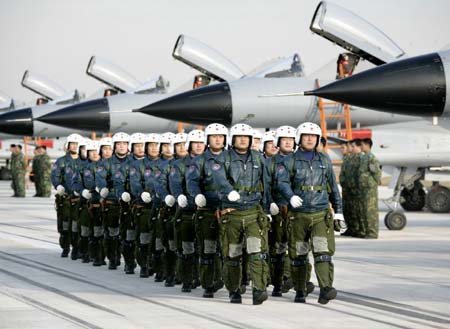China's armed forces begin to shed cloak of mystery
(Xinhua)Updated: 2006-12-31 08:49
BEIJING -- Chinese military drills, long known for being conducted in secret, were frequently reported by the media in 2006, an indication, say observers, of China's growing willingness to enhance military trust with other countries.
The "Friendship-2006" China-Pakistan joint anti-terrorism exercise, from December 11 to 18 in the hills of northern Pakistan's Abbottabad, allowed full coverage by the media from both countries.
The Chinese media also gave detailed reports on the shortcomings of the domestic "Queshan-2006" military drill from October 12 to 18 in the Jinan Military Region.
"China's military forces are striving to enhance their transparency. The openness and transparency of military drills reached to a very high level in 2006," said Chen Hu, military expert and executive editor-in-chief of "World Military Affairs" magazine.
"The high-level of transparency in bilateral military
drills illustrated that the military exercises do not infringe interests of the
third parties and other countries," said Senior Colonel Wang Weixing, deputy
chief of staff of a unit of the Chengdu Military Region, and the Chinese side's
chief exercise director in the "Friendship 2006" drill.
Domestic
Military Drills Open to Media
China's "Queshan-2006" military drill was in keeping with a realistic advance operational plan, involving a full complement of personnel and equipment in all-weather conditions.
The experts in the exercise directorate were just "looking for flaws". At the evaluation meeting, director Cui Yafeng spoke for 30 minutes, but only devoted two minutes to the achievements of the units while focusing on problems for 28 minutes.
The following day, all China's major media detailed data and vivid examples of the shortcomings of the drill: the division commander put off launching an offensive three times, to the point where the first echelon assault units stayed at the enemy's forward position for upwards of 50 minutes; the division requested firepower support, but did not provide specific times and targets; a new missile was launched at five targets, but only hit two; and individual units failed to set up radio stations, but rather used walkie-talkies and military mobile phones to communicate.
"In the past, all these things were regarded as military secrets," said a report made by Hong Kong-based Mingpao newspaper.
"The 'Queshan-2006' drill welcomed media to report all aspects and progress. The openness and transparency is rare anywhere in the world," said Chen Hu.
Other major domestic military drills this year opened doors to media. Reporters were allowed to enter and interview every unit and cover every corner; drill directors had to receive media's inquiries at any time; the codes, objectives and progress were all disclosed to the media.
Enhancing Trust Through Joint Drills
The fact that China conducted frequent exercises with other countries and opened domestic military drills to the media illustrated that China's armed forces had ushered in an "open and transparent" era, said Major General Peng Guangqian, a senior researcher with the Chinese Academy of Military Studies.
He said the openness mirrored the nation's open-door policy. The information era provided strategic opportunities for China's armed forces to narrow the gap with forces in advanced countries.
"The voluntary opening of China's military forces will help to enhance the trust between China and other countries," said Peng.
Peng's view was echoed by US Admiral Gary Roughead, commander of the United States Pacific Fleet.
He said transparency and mutual benefits could only be realized through communication, rather than through weapons.
"I have seen in my visit to China that our two navies and marines have much in common," the admiral said.
The navies of China and the United States held a search-and-rescue exercise on the South China Sea on November 19.
The exercise involved China's guided missile destroyer Zhanjiang, the fuel tanker Dongting Lake, the USS Juneau (LPD 10) and the USS missile destroyer Fitzgerald.
China's Yun-7 transport aircraft and the US P-3C patrol plane also participated in the exercise.
The two navies conducted communications, fleet formation changes and search-and-rescue exercises.
Observers said the Sino-US military relations had ushered in a new phase after the exercises and higher level personnel communications.
Prior to the Sino-US exercises, China had conducted more than ten bilateral or multilateral military drills with countries such as the United Kingdom, France, Pakistan, India, Australia, Thailand and Russia.
Overseas media reported the People's Liberation Army (PLA) had started to move from keeping military drills and its fighting capacity a secret to selecting opportunities to showcase its military power.
|
||
|
||
|
|

